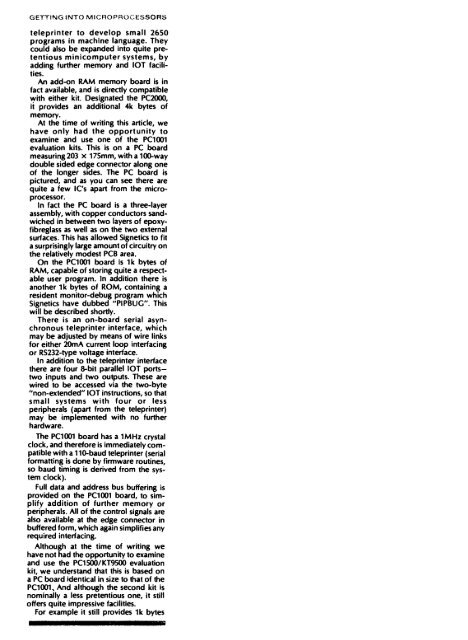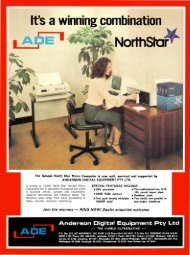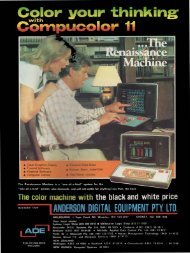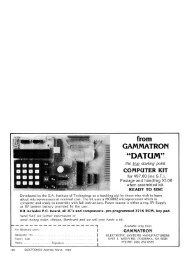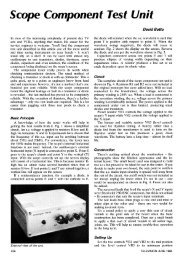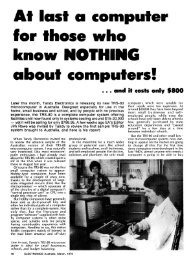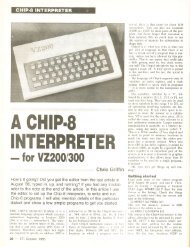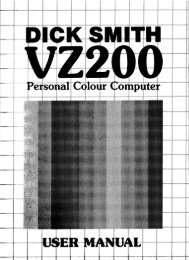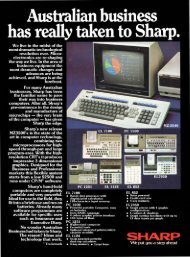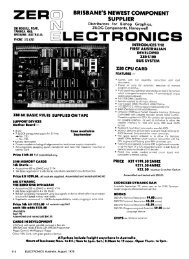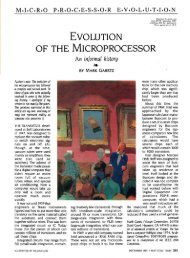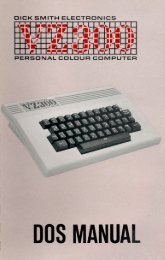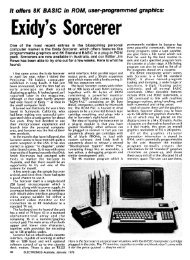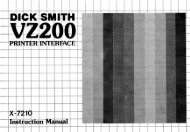The Signetics 2650 - The MESSUI Place
The Signetics 2650 - The MESSUI Place
The Signetics 2650 - The MESSUI Place
You also want an ePaper? Increase the reach of your titles
YUMPU automatically turns print PDFs into web optimized ePapers that Google loves.
GETTING INTO MICROPROCESSORS<br />
teleprinter to develop small <strong>2650</strong><br />
programs in machine language. <strong>The</strong>y<br />
could also be expanded into quite pretentious<br />
minicomputer systems, by<br />
adding further memory and IOT facilities.<br />
An add-on RAM memory board is in<br />
fact available, and is directly compatible<br />
with either kit. Designated the PC2000,<br />
it provides an additional 4k bytes of<br />
memory.<br />
At the time of writing this article, we<br />
have only had the opportunity to<br />
examine and use one of the PC1001<br />
evaluation kits. This is on a PC board<br />
measuring 203 x 175mm, with a 100-way<br />
double sided edge connector along one<br />
of the longer sides. <strong>The</strong> PC board is<br />
pictured, and as you can see there are<br />
quite a few IC's apart from the microprocessor.<br />
In fact the PC board is a three-layer<br />
assembly, with copper conductors sandwiched<br />
in between two layers of epoxyfibreglass<br />
as well as on the two external<br />
surfaces. This has allowed <strong>Signetics</strong> to fit<br />
a surprisingly large amount of circuitry on<br />
the relatively modest PCB area.<br />
On the PC1001 board is 1k bytes of<br />
RAM, capable of storing quite a respectable<br />
user program. In addition there is<br />
another 1k bytes of ROM, containing a<br />
resident monitor-debug program which<br />
<strong>Signetics</strong> have dubbed "PIPBUG". This<br />
will be described shortly.<br />
<strong>The</strong>re is an on-board serial asynchronous<br />
teleprinter interface, which<br />
may be adjusted by means of wire links<br />
for either 20mA current loop interfacing<br />
or RS232-type voltage interface.<br />
In addition to the teleprinter interface<br />
there are four 8-bit parallel IOT ports—<br />
two inputs and two outputs. <strong>The</strong>se are<br />
wired to be accessed via the two-byte<br />
"non-extended" IOT instructions, so that<br />
small systems with four or less<br />
peripherals (apart from the teleprinter)<br />
may be implemented with no further<br />
hardware.<br />
<strong>The</strong> PC1001 board has a 1MHz crystal<br />
clock, and therefore is immediately compatible<br />
with a 110-baud teleprinter (serial<br />
formatting is done by firmware routines,<br />
so baud timing is derived from the system<br />
clock).<br />
Full data and address bus buffering is<br />
provided on the PC1001 board, to simplify<br />
addition of further memory or<br />
peripherals. All of the control signals are<br />
also available at the edge connector in<br />
buffered form, which again simplifies any<br />
required interfacing.<br />
Although at the time of writing we<br />
have not had the opportunity to examine<br />
and use the PC1500/KT9500 evaluation<br />
kit, we understand that this is based on<br />
a PC board identical in size to that of the<br />
PC1001, And although the second kit is<br />
nominally a less pretentious one, it still<br />
offers quite impressive facilities.<br />
For example it still provides 1k bytes<br />
1111•111111111116. AIR


